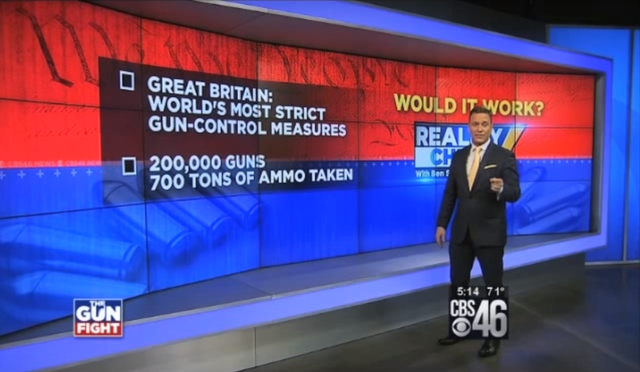Reality Check: Did Australia And Great Britain See Lower Gun Violence After Mass Confiscation?

Only days after mass shooting at the community college in Oregon, President Obama said that the United States needs to follow the lead of Great Britain and Australia—nations that instituted large scale gun bans and confiscation after mass shootings on their soil.
So would it work here?
Maybe the more important question is: did it work there?
“We know that other countries in response to one mass shooting have been able to craft laws that almost eliminate mass shootings,” Obama said. “Friends of ours, allies of ours, Great Britain and Australia, countries like ours.”
That was Obama speaking shortly after the community college shooting in Oregon.
The president says that Great Britain and Australia are great examples of nations that have taken control of gun violence. But are they?
It made us think—what is the real story behind those countries?
Let’s start with Great Britain.
On August 19, 1987, Michael Ryan killed 15 people and wounded 15 others in a series of random shootings around Hungerford, Berkshire. He also killed his mother before taking his own life. The pistol and two semi-automatic rifles he used in the massacre were all owned legally.
As a result, Great Britain enacted some of the world’s strictest gun-control measures in the late ’80s and ’90s. In Britain, a nation of 63 million people, more than 200,000 guns and 700 tons of ammunition have been taken off the streets during the past 15 years.
So what has the result been?
Early on, the ban appeared to have little impact, as the number of crimes involving guns in England and Wales rose heavily during the late 1990s to peak at 24,094 in 2003/2004.
Since 2004 though, the number of crimes involving guns has fallen each year. In 2010/11 there were 11,227 offenses, 53 percent below the peak number.
But that is not to say that this ban ended mass shootings in Great Britain, because it did not.
In 2010 a lone gunman killed 12 people in a four-hour shooting spree in northern England.
So what about Australia?
This is a more dramatic example.
In 1996, a 28-year-old man killed 35 people with a semi-automatic rifle in the Tasmanian city of Port Arthur. Twelve days later, a gun-confiscation program was rushed through the Australian parliament.
The National Agreement on Firearms all but prohibited automatic and semiautomatic assault rifles, stiffened licensing and ownership rules, and instituted a temporary gun buyback program that took some 650,000 so called assault weapons (about one-sixth of the national stock) out of public circulation.
The images are pretty incredible from that time. This agreement was called a gun buyback, but it really wasn’t. It was mandatory.
So what were the effects of this program?
Interestingly, there have been at least two major studies done on the program and gun homicides. University of Melbourne researchers Wang-Sheng Lee and Sandy Suardi did the first, and in 2008 they completed a report on the matter saying:
“In this paper, we re-analyze the same data on firearm deaths used in previous research, using tests for unknown structural breaks as a means to identifying impacts of the National Firearms Agreement. The results of these tests suggest that the NFA did not have any large effects on reducing firearm homicide or suicide rates.”
“In this paper, we re-analyze the same data on firearm deaths used in previous research, using tests for unknown structural breaks as a means to identifying impacts of the National Firearms Agreement. The results of these tests suggest that the NFA did not have any large effects on reducing firearm homicide or suicide rates.”
And a second report concluded that while the mandatory program did reduce the rate of “accidental” firearm deaths, it had no influence on firearm homicide in Australia and it also did not end mass shootings.
In 2002 two people were killed and five were injured in a shooting at Melbourne’s Monash University. In 2011 three people were killed and three were wounded in the Hectorville siege. In 2014, three people (including the gunman) were killed and four were injured in a Sydney hostage crisis.
What you need to know is that even with mass confiscation of weapons, Australia could not end all mass shootings and the rate of gun homicides wasn’t actually affected.
But here is something else worth mentioning: the 650,000 guns confiscated in Australia were between one-fifth and one-third of all guns in the country.
Compare that to the United States and that would require confiscation of around 105 million firearms—something that would not only be unconstitutional but would likely become incredibly violent.
In other words, mass confiscation in the United States, simply cannot happen. Not right now—possibly not ever.
That’s Reality Check. Let’s talk about that on Twitter @BenSwann_
https://www.facebook.com/CBS46/videos/10153720993101252/
Posted from my blog with SteemPress : http://truists.org/reality-check-australia-great-britain-gun-violence/